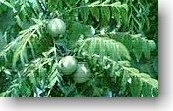Due to the many misunderstandings
regarding who said what and how black walnut is to be used, I hit
the books. As always, Maude Grieve was wonderful. The botanical
name of the American black walnut is
Juglans nigra. The
European nut is probably of Persian origin. Grieve states that
the species known as
Juglans regia can be found far to the
East of Persia: to the Hindu Kush, Kashmir, and Sikkim. The tree
was grown throughout the Roman Empire. It was described by Varro
(born c. 116 A.D.)
The Romans called the tree "nux" because
of its fruit. The name walnut is of German or Teutonic origin and
means something foreign (welsche). The botanical name is
more interesting. Juglans comes from Jovis glans, Jupiter's
nuts, which continues to be a name by which walnut is known in
some parts (no pun intended.)
 The
two species, nigra and regia, contain the same quinone,
juglone, so authorities that I checked believe the plants possess
similar if not identical medicinal properties. Juglone is not only antiparasitic but antifungal and antimicrobial. This is found in all parts of the tree and it inhibits competitive growth around the tree.
The
two species, nigra and regia, contain the same quinone,
juglone, so authorities that I checked believe the plants possess
similar if not identical medicinal properties. Juglone is not only antiparasitic but antifungal and antimicrobial. This is found in all parts of the tree and it inhibits competitive growth around the tree.
The herbal medicine is made from the hulls that encase the nut and it is generally regarded as safe to consume black walnut at the recommended dosages for two weeks. Prolonged use is discouraged.
My Early Studies
When first trying to understand black walnut, I consulted a number
of reputable sources. Weiss says that walnut is a common
household remedy for skin conditions such as eczema,
scrofula, and inflammation, but he prefers wild pansy. Weiner cites
the Cherokee use as an anthelmintic (vermifuge), most particularly
for tapeworms. He suggests the oil of the
fruit whereas some use the inner bark and most today use the green
hull. All sources seem to concur that walnut is one of the mildest
and surest laxatives, causing no nausea,
irritation, or pain. Some recommend that use of this preparation
be followed by something stronger such as pinkroot or even calmyrna
figs (which supposedly can rip the skin of worms.)
Grieve says the bark and leaves of
the walnut can be used in most skin diseases, basically everything
from eczema to herpes
and syphilis. Stronger doses have a purgative
effect. More importantly, Grieve states that the unripe
nut has "worm-destroying virtues." Ergo, the idea did not originate
with Hulda Clark or Hanna Kroeger or any of the more controversial
figures of the late 20th century.
Grieve makes fascinating reading.
She goes on to mention vinegar walnut gargles for sore and ulcerated
throats, catsup made of walnuts having properties similar to the
unripe nuts. After reading what she wrote, I thought that perhaps
the macrobiotic people use sesame oil (in part as an antiparasitic
protocol) while the French use walnut oil. Grieve says the leaves
contain iodine and are a powerful insect repellent. Then, if the
husks and leaves are macerated in warm water, the taste is intensely
bitter and the concoction will kill all worms (so use it on your
antique furniture?) She said the liquid made in this way can be
poured on lawns without injuring the grass itself. Grieve has lots
of marvelous sounding recipes including one using the juice of
the green hulls, boiled with honey (well, those of us conditioned
by Ayurveda will add the honey at the last minute when there is
still a chance of blending it with the other liquid.) She recommends
this as a gargle for sore throats. She also states that walnut
has been called the "vegetable arsenic" because of its curative
powers with skin diseases.
Doctrine of Signatures
Then, the doctrine of signatures
refers to the similarity between the walnut and the head: the outer
husk of green covering represents the pericranium . . . ergo "salt
made of those husks or barks are good for wounds of the head." The
inner woody shell resembles the skull and the little yellow peel
(inside the walnut) corresponds to the meninga and pia-mater. The
kernel has the same appearance as the brain and is therefore "profitable
to the brain and resists poisons." Quoting William Cole (1657), "if
the kernel be bruised and moistened with wine and laid upon the
crown of the head, it comforts the brain and head mightily." There
are fascinating recipes, so interesting that I think I'll post
them when I have a chance. Lastly, Peter Holmes, my friend and
sometimes mentor, a most scholarly man: he is lengthy, not any
longer than Grieve, but says the uses include (1) lymphatic congestions,
eczema, and tumors (metabolic toxicosis with damp cold); (2) blood
deficiencies and demineralization; (3) intestinal parasites (especially
round and tapeworms) and diabetes; and (4) tissue repair, bacterial
and fungal skin infections, bone degeneration. Peter goes on to
discuss Walnut liqueur (from green nut -- not hull) as a traditional
European aperitif and many other uses. I have found nothing to
explain the reference to intestinal flora by one producer, but given that they could probably sell 20 times
more by referencing parasites, probably did not pull the idea out of thin air.
Copyright by Ingrid Naiman
2004
Revised 2009

 The
two species, nigra and regia, contain the same quinone,
juglone, so authorities that I checked believe the plants possess
similar if not identical medicinal properties. Juglone is not only antiparasitic but antifungal and antimicrobial. This is found in all parts of the tree and it inhibits competitive growth around the tree.
The
two species, nigra and regia, contain the same quinone,
juglone, so authorities that I checked believe the plants possess
similar if not identical medicinal properties. Juglone is not only antiparasitic but antifungal and antimicrobial. This is found in all parts of the tree and it inhibits competitive growth around the tree.